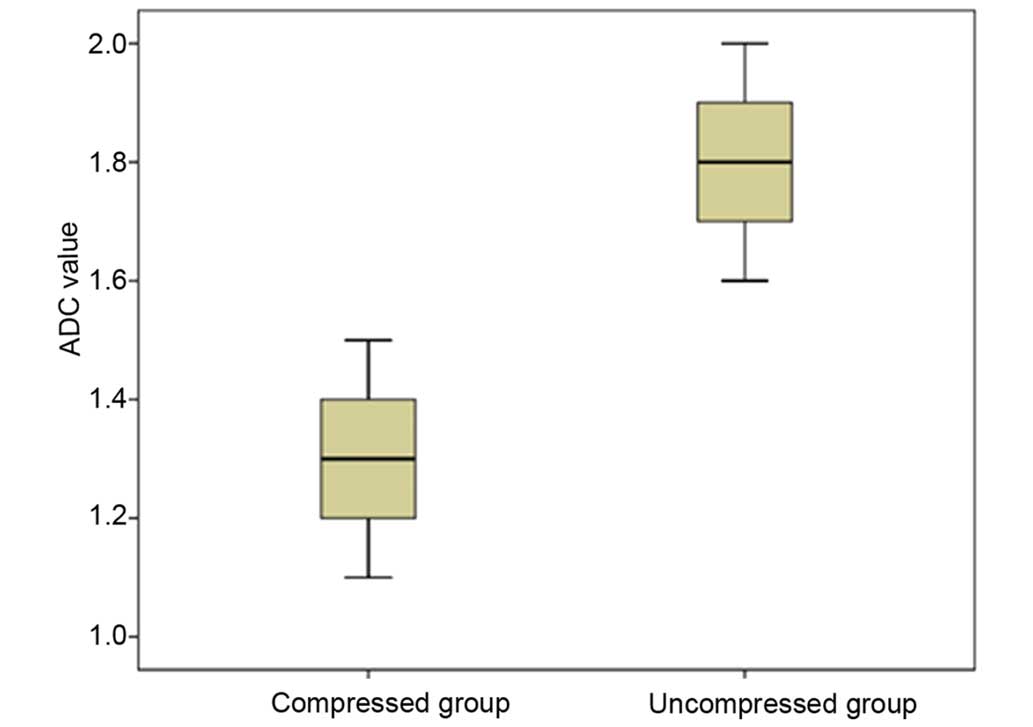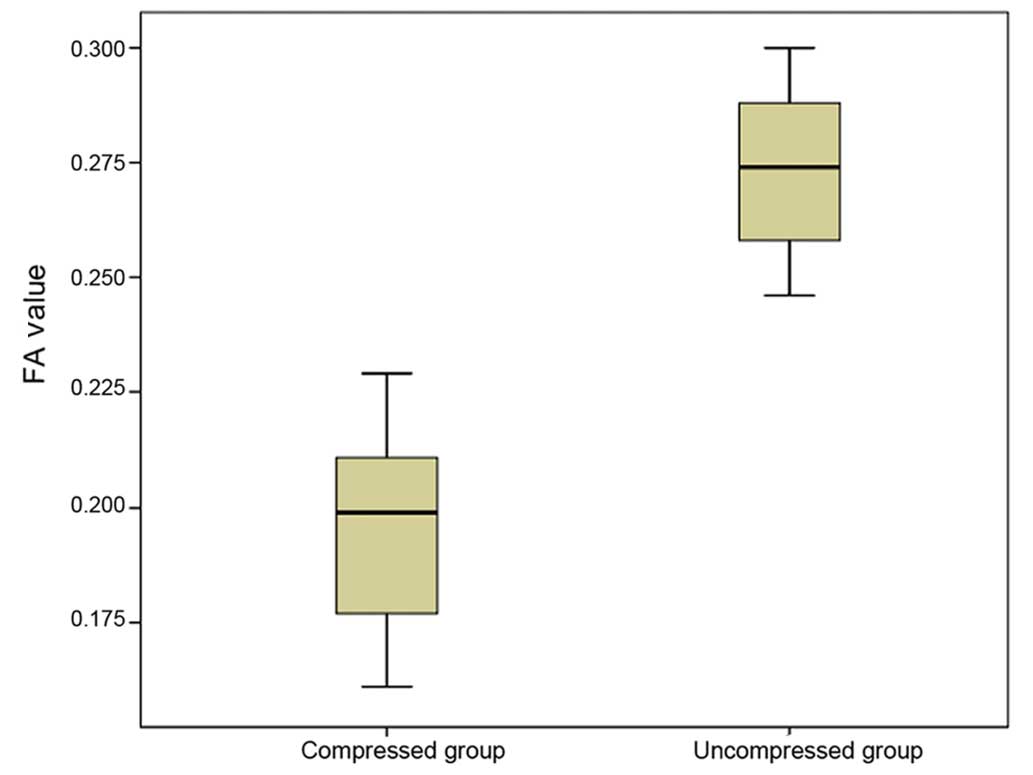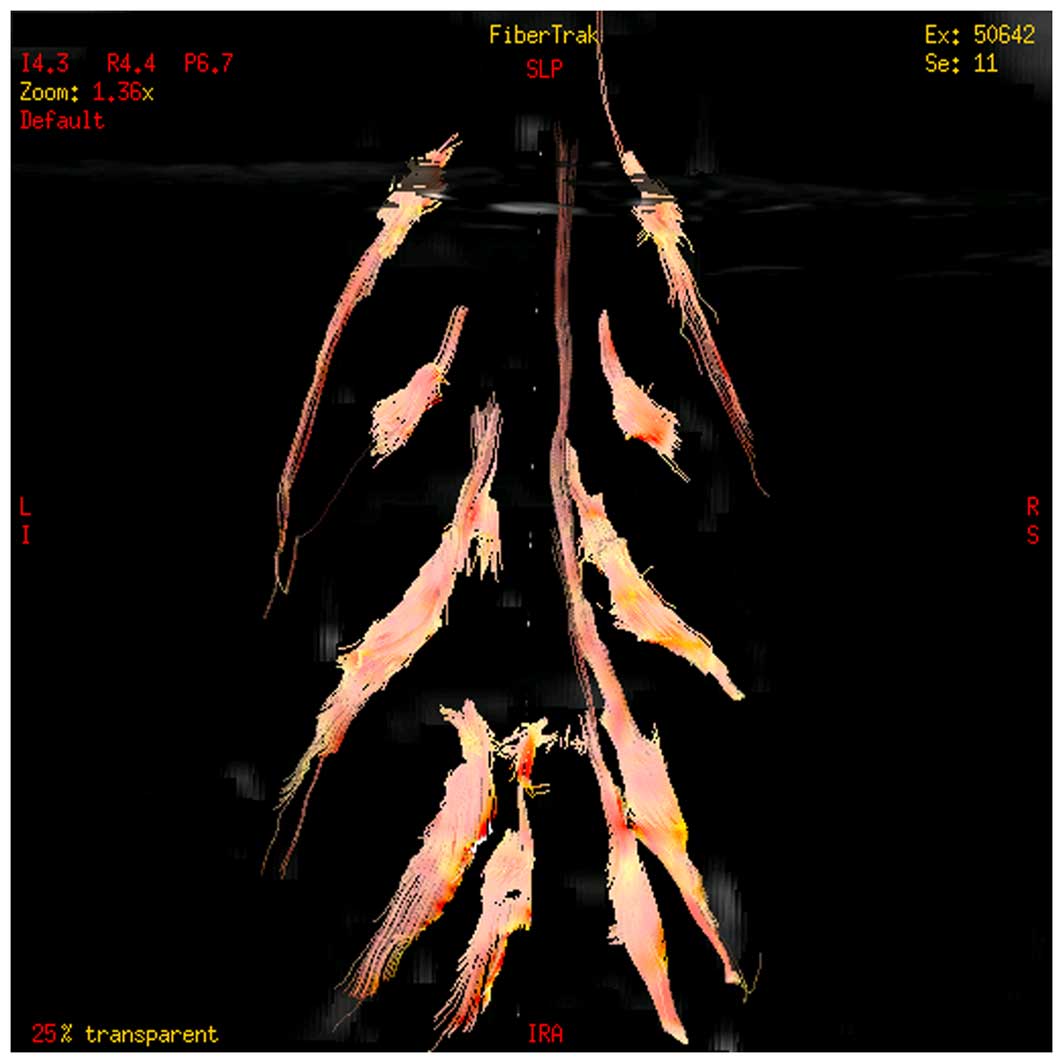Study on lumbosacral nerve root compression using DTI
- Authors:
- Published online on: August 2, 2016 https://doi.org/10.3892/br.2016.734
- Pages: 353-356
Abstract
Introduction
Magnetic resonance imaging (MRI) is a commonly used advanced inspection technique in clinical and scientific research. At present, the new technology mainly includes functional MRI, magnetic resonance spectroscopy, three-dimensional spoiled gradient recalled echo and diffusion tensor imaging (DTI). These technologies have been extensively applied in the brain, spinal cord lesions and tumors.
DTI is an MR technique developed on the basis of the diffusion-weighted imaging (DWI). DTI collects attenuated signal intensity induced by a diffusion of water molecules in all directions of space through a diffusion sensitive gradient in numerous directions, quantitatively describes the three-dimensional trajectory of spatial diffusion, and can provide a diffusion direction characteristic of living tissue (1). Under physiological conditions, the diffusion rate of water molecules in each direction is different, i.e., diffusion anisotropy. DTI can measure the direction and degree of diffusion of the water molecules in a three-dimensional space, describe anisotropic characteristics of tissue and precisely investigate the distribution of fibers (2,3). Diffusion anisotropy has been found in muscle, and has also been detected in the spinal cord and white matter of living tissue in the late 1980s. White matter anisotropy is induced by paralleled distributed myelinated nerve fibers (4). The diffusion of white matter was faster in paralleled fibers compared to vertical fibers. This feature with a color mark can reflect spatial directivity of the white matter. Thus, the fastest diffusion direction is the direction of fiber distribution. It is the same in DTI of skeletal muscle and myocardium. With the advancement of studies regarding DTI, the DTI application has become an area of interest for human functional imaging. Since Clark et al (5) applied DWI in the spinal cord in 1999, the application of DTI in the spinal cord already has certain initial experience from ex vivo; in vivo animal to human. DTI is sensitive to the appearance of disease, but currently, studies on spinal cord DTI are scarce (6,7). This is mainly due to the special structure of the spinal cord. The cross-sectional area of the spinal cord is relatively small. The axial spinal cord is oval and uneven in thickness, so the spinal cord DTI requires an imaging sequence of high resolution and high signal-to-noise ratio.
DTI is the only method to non-invasively visually reveal fiber tractography, a unique method to evaluate pathophysiology of spinal cord diseases, and is mainly used to diagnose and assess injury, cancer, inflammation and myelomalacia. DTI is not only extensively applied in the diagnosis and evaluation of spinal cord diseases, but also in other diseases. The fibrous ring of the intervertebral disc is composed of arranged collagen fibers, and has directivity. Therefore, DTI can exhibit the distribution of fibers of the fibrous ring in vivo. As the only method to exhibit a nerve fiber bundle in vivo, the application of DTI in the central nervous system is becoming increasingly extensive.
Materials and methods
Subjects
A total of 45 subjects with intervertebral disc degeneration, at the age of 23–66 years (average, 55.98±11.98 years), were enrolled in the study, including 25 males and 20 females. All the subjects suffered from varying degrees of intervertebral disc degeneration and spinal canal stenosis. Tumor and various metabolic diseases were excluded. All the subjects signed informed consent. The study was approved by the Ethics Committee of the Chinese People Liberation Army (PLA) General Hospital (Beijing, China).
Equipment
A 3.0 T superconductive MRI machine (MR750; GE Healthcare, Milwaukee, WI, USA) was used with an 8-channel spine coil, gradient field 40 mT/m and gradient switching rate 150 mT/m·sec.
Image collection
An axial DTI scan was conducted with a single-shot spin-echo echo planar imaging sequence with the following parameters: TR/TE=10,000/72.3 msec; b value, 600 sec/mm2; slice thickness, 3.0 mm; layer spacing, 0; number of layers, 39; matrix, 128×128; FOV, 24×24 cm; and NEX 1.0, diffusion sensitive gradient direction 15.
Experimental design and implementation
According to the nerve root compression conditions, samples were divided into the compressed and uncompressed groups. The scan was performed by a technician from the Department of Radiology (Chinese PLA General Hospital). Prior to scanning, subjects were informed that their body would remain stationary during the scan.
Image analysis
Original images of DTI were loaded onto the AW4.4 (Advantage Windows; GE Healthcare) workstation, and measured using FuncTool software. The apparent diffusion coefficient (ADC) and fractional anisotropy (FA) were calculated. The region of interest (ROI) was placed on three continuous scan planes, once every plane. Nerve roots at the proximal, central and distal intervertebral foramina were separately measured (Fig. 1) three times. The average value of the three measured results was considered the final ADC and FA values. The ROI size was 20–40 mm2 (Fig. 1). ADC and FA values of the bilateral nerve roots in L3-L4, L4-L5 and L5-S1 were measured in 45 subjects.
Statistical analysis
Quantitative data are expressed as mean ± standard deviation, and analyzed using a group t-test between the two groups. P<0.05 was considered to indicate a statistically significant difference.
Results
Comparison of ADC and FA values in the compressed and uncompressed groups
Among the 45 subjects, the number of nerve roots was 122 in the compressed group and 148 in the uncompressed group. Group t-test indicated that the ADC values were significantly lower in the compressed group (1.314±0.140×10−3 mm2/sec) compared to the uncompressed group (1.794±0.111 mm2/sec) (P=0.001) (Fig. 2). FA values were significantly lower in the compressed group (0.196±0.020) compared to the uncompressed group (0.272±0.016) (P=0.013; Fig. 3).
Tracer display
Among the 45 subjects, the DTI scan exhibited the distribution and compression of the nerve root in 36 subjects (Fig. 4).
Discussion
The spinal cord reaches the lumbar spinal canal, and ends at the corresponding level of the L1-L2 intervertebral disc. The lumbar, sacral and caudal nerve roots of the ventral and dorsal sections fix the spinal cord in the spinal canal. Descending nerve roots from the spinal cord go sequentially into their respective intervertebral foramina. Local nerve root morphology is similar to horsetail fibers, and is therefore known as cauda equina. Certain degenerative changes, such as intervertebral disc protrusion and the thickening of ligamentum flavum, can impact nerve roots and cause pain. Nucleus pulposus of the prolapsed intervertebral disc can produce an inflammatory mediator, impact the nerve root, and lead to pain.
With the rapid development of MRI and the increasing maturity of image processing technologies, numerous processing technologies of computational neuroanatomy are emerging. DTI can objectively describe the distribution of nerve roots in morphology, and provide a set of objective reference data on the quantitative indicators. A previous study verified that the effects of age and gender on ADC and FA values were not apparent in normal nerve roots (1). DTI, as a new imaging technique, can sensitively find the nerve root changes by measuring the ADC and FA values. Using the conventional method on ROI, according to the size of the nerve root cross-section at the proximal, central and distal intervertebral foramina, ROI was generally set at 30–70 mm2, and the effect of ROI size on measurement results was not evident (1).
DTI is a new and non-invasive MRI technique, and is mainly used to quantitatively evaluate microscopic structural changes of the nervous system, and to detect the blocking effect of cell membranes and myelin sheath on the movement of water molecules in the brain, particularly diffusion of water molecules in fiber bundles of the white matter, such as high anisotropy (2,3). Thus, the diffusion was faster in water molecules parallel to the direction of axon and myelin sheath than in vertical direction (2,3). The structure of fiber bundles observed by FA images was basically identical to that of the real fiber bundles (4). The voxel analysis of FA value can sensitively reflect brain lesions to a certain degree (6,7). The structure of fiber bundles of lumbosacral nerve roots is identical to that of intracranial nerve fibers, so their imaging principles are identical.
The imaging method of lumbosacral nerve roots consists of 3D FIESTA, MR PROSET technology, MRSSI (selective excitation) technology CUBE-FLEX and DTI. Several previous methods involve three-dimensional volumetric imaging. Occasionally, tissues with similar signals may interfere with the image quality. For example, vascular effects may interfere with nerve root display. DTI of lumbosacral nerve roots has been initially used in clinical research, but has not been extensively employed in the clinic due to the limitation of computer processing and imaging results. This method can provide a quantitative reference value of nerve root (ADC and FA values). In the reconstruction of the fiber bundle, a desired minimum threshold should be determined. If the minimum threshold is set too low, the reconstructed nerve fibers contain too many tissues and the edge is rough, so therefore the form of normal nerve fibers will be lost. If the minimum threshold is set too high, nerve fibers are rare. In the present study, the minimum threshold was set at ~200, the obtained DTI images can objectively reflect the real condition of nerve roots. The biggest advantage of DTI is to quantify the research index. The present results revealed that the ADC and FA values of the compressed nerve roots were evidently lower compared to that of the uncompressed nerve roots, which is consistent with a previous study (1).
In conclusion, the ADC and FA values of the nerve roots were evidently lower in the compressed group compared to the uncompressed group. DTI tractography can satisfactorily exhibit the compression of nerve roots and can quantitatively assess the compression of lumbosacral nerve roots in patients with lumbar disc degeneration.
Acknowledgements
The present study was supported by the PLA 12th five-year research project (grant no. CWS11J101).
References
|
Kitamura M, Eguchi Y, Inoue G, Orita S, Takaso M, Ochiai N, Kishida S, Kuniyoshi K, Aoki Y, Nakamura J, et al: A case of symptomatic extra-foraminal lumbosacral stenosis (‘far-out syndrome’) diagnosed by diffusion tensor imaging. Spine. 37:E854–E857. 2012. View Article : Google Scholar : PubMed/NCBI | |
|
Basser PJ: Inferring microstructural features and the physiological state of tissues from diffusion-weighted images. NMR Biomed. 8:333–344. 1995. View Article : Google Scholar : PubMed/NCBI | |
|
Basser PJ, Mattiello J and LeBihan D: MR diffusion tensor spectroscopy and imaging. Biophys J. 66:259–267. 1994. View Article : Google Scholar : PubMed/NCBI | |
|
Pierpaoli C, Jezzard P, Basser PJ, Barnett A and Di Chiro G: Diffusion tensor MR imaging of the human brain. Radiology. 201:637–648. 1996. View Article : Google Scholar : PubMed/NCBI | |
|
Clark CA, Barker GJ and Tofts PS: Magnetic resonance diffusion imaging of the human cervical spinal cord in vivo. Magn Reson Med. 41:1269–1273. 1999. View Article : Google Scholar : PubMed/NCBI | |
|
Albrecht J, Dellani PR, Müller MJ, Schermuly I, Beck M, Stoeter P, Gerhard A and Fellgiebel A: Voxel based analyses of diffusion tensor imaging in Fabry disease. J Neurol Neurosurg Psychiatry. 78:964–969. 2007. View Article : Google Scholar : PubMed/NCBI | |
|
Abe O, Yamasue H, Kasai K, Yamada H, Aoki S, Iwanami A, Ohtani T, Masutani Y, Kato N and Ohtomo K: Voxel-based diffusion tensor analysis reveals aberrant anterior cingulum integrity in posttraumatic stress disorder due to terrorism. Psychiatry Res. 146:231–242. 2006. View Article : Google Scholar : PubMed/NCBI |













